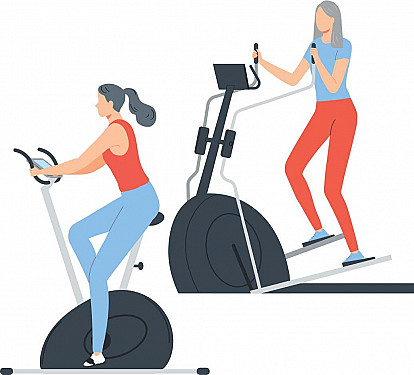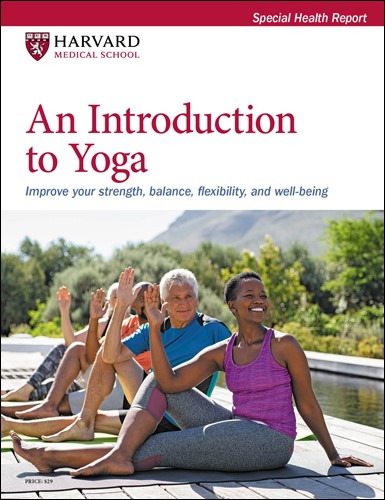Need more inspiration to exercise? Don't go it alone
Exercising with a buddy or in a group setting may motivate you to boost your step count and overall physical activity.
- Reviewed by Christopher P. Cannon, MD, Editor in Chief, Harvard Heart Letter; Editorial Advisory Board Member, Harvard Health Publishing

Sticking to an exercise routine is a challenge for many people. New research suggests that a little support from your friends can help. Older adults who talked with peers about their exercise regimen were able to increase and sustain their physical activity levels much better than those who focused on self-motivation, according to a study in the Feb. 5, 2024, JAMA Network Open.
"It's a really interesting study that's going to change my prescribing practices," says Dr. Stephanie Collier, a psychiatrist at Harvard-affiliated McLean Hospital. She prescribes exercise to her patients to improve mood and overall health. "Instead of focusing solely on helping them set individual goals, I'll also urge them to connect with other people when they exercise," she says.
The power of peer support
The study included 309 people ages 70 and older who weren't meeting physical activity guidelines. All were given a wearable fitness tracker and an exercise program and randomly divided into four groups. One group received intrapersonal coaching, which included coaching on self-directed actions like personal reflection, setting goals (such as higher step counts), and making plans to add more activity into their daily routines. Another group received interpersonal coaching, which included chatting with peers to learn and share information, including their experiences and motivations to exercise. The third group received both types of coaching, and the fourth received neither intervention.
For eight weeks, all participants attended weekly meetings that featured discussion, practice, and instructions about the exercise program and their assigned coaching. Researchers then checked in with them after a week, six months, and 12 months. The interpersonal coaching group showed marked improvements in their activity levels over the entire year, boosting their average daily activity by 22 to 25 minutes per day and their average daily step counts by nearly 1,000 steps. The group that received both intrapersonal and interpersonal coaching had similar improvements. But those who got just intrapersonal coaching or no coaching didn't change their exercise habits.
Finding your fit
If you need to start moving more, finding an activity you enjoy doing is the first step. "I let my patients decide what works best for them," says Dr. Collier. Walking is a popular option because it's convenient, but it's also good to try different exercises that improve strength and balance, she adds.
Whatever you do, try to find an exercise partner — whether that's your spouse, sibling, friend, or neighbor — to join you. Find a mutually convenient time at least once or twice a week when you can take a walk, go a fitness center, or take a class (see "Exercise classes: Something for everyone"). Classes have the added advantages of providing structure, a trained instructor, and camaraderie from the group. If you can't persuade a partner to join you, a class can be a good way to meet like-minded people and expand your social circle.
Consider exploring alternatives that Dr. Collier's patients have tried, such as doing an online yoga class with a friend (either together or each in your own house) or hiring a personal trainer to instruct a small group of your friends and neighbors. "One of my patients teaches line dancing for seniors," she says. Other possibilities include joining a walking, hiking, or cycling group, or even a senior sports league — the competition may inspire you to work a little harder. Several sports have been adapted for seniors, such as volleyball with lower nets and softer balls. Signing up to do a charity walk can also be a good motivator and connects you with lots of people.
Finally, if you have a wearable fitness device that tracks your steps or exercise, share your progress with friends (either individually or on social media) which might help motivate them to be more active. "It's a good way to make the intrapersonal more interpersonal," says Dr. Collier.
Exercise classes: Something for everyoneTo find group exercise classes, check your local community center, senior center, or YMCA. You can often find variety of classes, one of which might spark your interest. Here are some possibilities. Dance: African, belly, ballroom, ballet, Latin, country line, tap, soul, and Zumba. Martial arts: Karate, tae kwon do. Racquet sports: Table tennis, badminton, racquetball, squash, pickleball, tennis. Mind and body: Yoga, Pilates, tai chi, qi gong. Water sports: Swimming, aqua aerobics. |
Image: © FG Trade Latin/Getty Images
About the Author

Julie Corliss, Executive Editor, Harvard Heart Letter
About the Reviewer

Christopher P. Cannon, MD, Editor in Chief, Harvard Heart Letter; Editorial Advisory Board Member, Harvard Health Publishing
Disclaimer:
As a service to our readers, Harvard Health Publishing provides access to our library of archived content. Please note the date of last review or update on all articles.
No content on this site, regardless of date, should ever be used as a substitute for direct medical advice from your doctor or other qualified clinician.
















